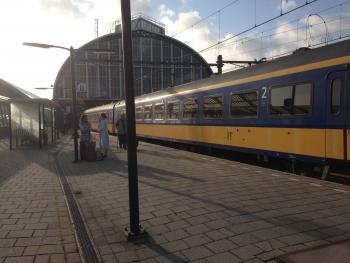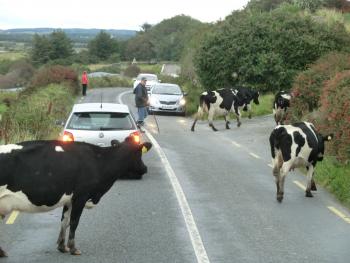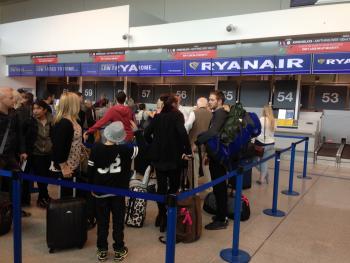Tips on transportation in Europe
This article appears on page 45 of the September 2016 issue.
I prefer to travel independently rather than with a tour group, and, over the years, one of the benefits of planning my own travel has been achieving a level of expertise in the various transportation systems abroad. On our September 2015 trip to Europe, my wife, Kris, and I and four friends used quite a few different conveyances to get around, many of which we booked before we left the US.
Trains
Train travel in Europe is generally safe, efficient and fast. Traveling by train with full suitcases can be somewhat stressful, however.
I remember older trains that had large luggage racks at either end of each car, but above-the-seat storage (as on airplanes) was more common on this trip. Lifting my wife’s suitcase containing what I can only guess was her anvil collection above my head was challenging… and getting it back down, mildly dangerous for the people in the nearby seats.
Tip — If sitting by the window beside an empty seat, don’t leave your carry-on bag on the seat next to you. One of our traveling companions did that on a train from Amsterdam to Belgium, and just a few stops out of the city, a well-practiced thief ran down the aisle, grabbed the bag and disappeared out the train doors just as they were closing.
We took trains three times on this 16-day trip to Amsterdam, Bruges, London, England’s Lake District and Galway. Each rail journey took from two to three hours.
The Amsterdam-to-Bruges trip and Bruges to London cost $60 to $70 apiece. The one in England (London to Manchester) cost less than half that.
Timing is important when purchasing tickets. The best deals are usually available about 90 days before departure and should be booked for nonpeak times (i.e., not during rush hour). Last year we paid about twice as much for a train trip from Glasgow to Windermere as we did for the return because I didn’t know this rule.
The amount of walking required for train travel should not be underestimated, especially for those with mobility issues.
In Brussels we had 14 minutes to connect to our train to Bruges — a substantial amount by European standards. The transfer required walking several hundred yards from the end of one train into the terminal, finding the right platform for the next train, then walking a few hundred yards more to our designated railcar on another level. All this was done with luggage amid crowds of people attempting to do the same thing.
At London’s Euston Station, I was especially irritated to discover they use the same ridiculous grouping system as is used in British airports. The platform location of your train is concealed from you until the last possible moment. By the time it is finally revealed, you have mere minutes to find the platform and drag your luggage to it. In this case, it was Platform One, at the end of the station and 17 cars down the track. We just made it.
All three European trains that we took were comfortable, although the air-conditioning in our car on the British train wasn’t working right. (On my way to the food car, I passed through several much cooler cars.)
The Thalys train from Amsterdam to Bruges and the Chunnel train to London were both very high-speed. I have an app for my phone called Speed Box that clocked speeds as high as 186 mph on each trip.
Planes
We flew on the bargain-basement carrier Ryanair from Manchester to Dublin, paying about a hundred dollars apiece for the hour-long flight. (If we had been traveling without luggage, we could have flown for less than $20.) The comfort level was not high.
Even though we held boarding passes for what is considered business class on that airline, we were forced to wait in line for about 40 minutes to check our luggage. Another long line at security gave way to almost an hour in the holding pen.
After waiting for the big reveal — “Go to Gate 52. Now.” — we stood in line at the gate for the plane to actually arrive. When it did, we were herded down three flights of what felt like an emergency stairwell.
More waiting on the steps ensued while the incoming passengers deplaned. Finally, they opened the doors so we could race across the tarmac and board the plane from both the front and back.
Taxis
We used taxis on this trip more than we have in the past, mostly because our time at each place was so limited. However, instead of a cab, my wife and I took bus 197 from the Amsterdam airport to the museum district (€5, or $5.50). We then walked about five blocks in a light rain to our hotel. The other four people in our group did take a cab. They paid about €10 each and were dropped off at the door of the hotel.
Two days later we had the hotel arrange a van to the train station for all six of us. Luckily, we had built in plenty of time before our scheduled departure because we ended up spending about 15 minutes sitting in the stopped van while the veteran taxi driver argued with a young policeman about whether he had a right to drive on the street’s tram tracks.
The cabbies we encountered in London were efficient but did their jobs with a level of indifference that bordered on arrogance. London cabs do not have trunks, and our drivers felt no need to leave their throne to help while we struggled with how to configure the luggage (Hint — There’s extra storage in front next to the driver.)
Buses, trams and subways
Generally, public transportation systems are the best way of getting around European cities, although we used them sparingly this time.
We took a very comfortable Citylink bus from Dublin’s airport to Galway for about $16.
We also spent a day on a tour in Galway that included a bus ride to the Cliffs of Moher and a boat trip to the Aran Islands. The $45 price for the all-day tour was hard to beat, and the driver was knowledgeable and entertaining. (For more information, visit www.galwaytourcompany.com.)
Bikes
Guidebook writer Pauline Frommer adamantly warns against renting a bike in Amsterdam. Though we briefly considered it, we ultimately chose to follow her advice.
Bikes rule the city. Ruthlessly.
Last summer I rented a bike in Copenhagen — another terrific biking town — and had a great time, but Amsterdam is a breed apart because of the volatile mix of cars, trams, pedestrians and bikes. We asked our cab driver if there were a lot of bike accidents in Amsterdam. His caustic reply was, “Not enough.”
Rental cars
We rented cars twice on this trip, once in England and again in Ireland. If you’re intimidated by narrow roads with blind turns in unfamiliar cars with the steering wheel on the wrong side, don’t drive in these countries.
Driving in Ireland and Britain is a group activity, with at least one navigator needed while others in the car alert the driver to surprises (such as sheep in the road ahead) or guess the right exit in a roundabout.
On a map, the Avis location in Manchester Piccadilly (downtown) looked very close to the train station, but in reality it was in what had to be one of the least desirable parts of the city, somewhere behind and below the station.
My friend Chuck and I spent about an hour tracking it down, renting the car and returning to the station for our passengers, who were waiting with the luggage.
Our Irish Hertz rental was a midsize automatic — much easier to drive than the outsized minivan they gave us in England as an “upgrade.” Although both vehicles on this trip were automatics, most of the time I rent the much cheaper and more common standard-transmission cars (though shifting with your left hand takes some practice).
Having a GPS in the car is mandatory, as far as I’m concerned. We found that street signs were rare and erratically placed, directions (such as north or south) were absent from highway road signs, and upcoming turns were often completely blind.
On foot
Walking is still my favorite way of getting around, and our Fitbit rarely measured fewer than 10,000 steps in a day (and often significantly more).
The following were among some great walks: a morning ramble through London to the Apple Store to get my phone fixed; a torch (flashlight) walk on a pitch-black country lane in Cumbria that opened onto hilly fields full of iridescent white dots that proved to be sheep, and a pleasant mile talking golf with a Canadian academic on Inisheer, the smallest of the Aran Islands.



